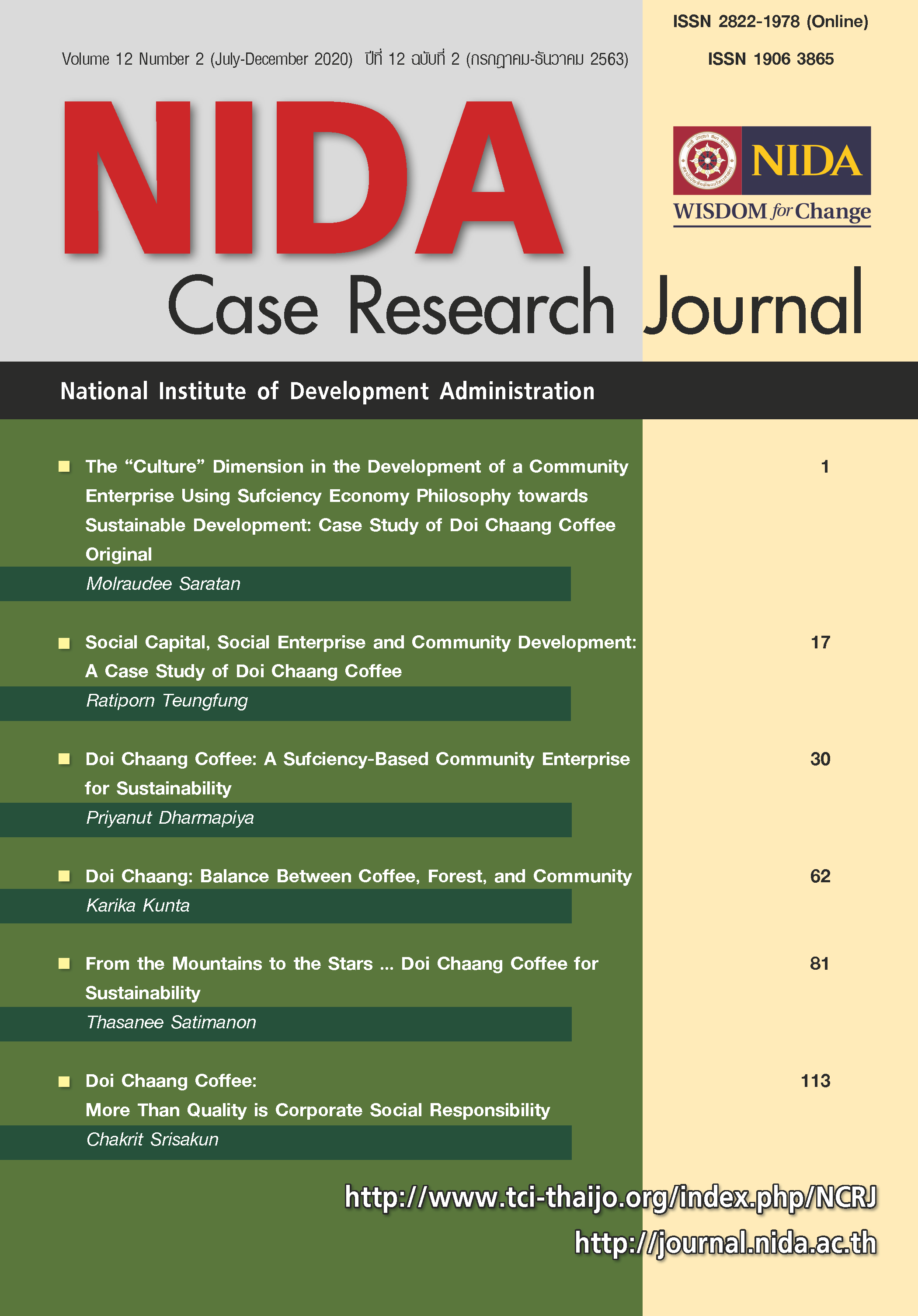From the Mountains to the Stars ... Doi Chaang Coffee for Sustainability
Keywords:
Doi Chaang, product differentiation, market structure, international standardAbstract
The agricultural sector is still an essential economic sector in Thailand due to the high proportion of agricultural laborers. However, most agricultural products are products that farmers cannot determine their prices. From the predetermined market price, farmers have a higher chance of selling them at a loss. Differentiation and diversification of agricultural products allow farmers to have market power and be able to set their prices. Thus, farmers’ market structure has changed from the perfectly competitive market to the monopolistic competition market. Doi Chaang Coffee is an intriguing case study of Doi Chaang villagers who used to face the same problem since their middlemen had high bargaining power. The situation encouraged the leaders of the Doi Chang people (Khun Panachai Phisailert or Adel) to consult and ask for help with Khun Wicha Phromyong, the primary decision-maker of this case study. Khun Wicha had to decide whether Doi Chaang villagers should take a high level of effort and spend many years developing their coffee quality or not. If successful, the villagers would no longer be a price taker; if not, they could choose other alternatives such as changing to grow other crops. Furthermore, if the villagers decide to produce high-quality coffee, they should apply for international standards which generate high costs, or not.
References
Ritpreecha O. (2008). Doi Chaang Coffee: Memorandum of the struggle for Doi Chaang prestige. 1st ed. Chiang Mai: Pongsawas Publisher.
Eleven differences between Arabica and Robusta coffee. (2016). Retrieved September 9, 2019, from http://coffee-education.com/arabica-robusta/
What is coffee roasting and how does it affect coffee flavor? (2019). Retrieved September 9, 2019, from https://www.koffeetools.com/content/6315/การคั่วกาแฟคืออะไร-มีผลต่อรสชาติกาแฟอย่างไร"
Doi Chaang Coffee. (2019). Retrieved September 16, 2019, from https://doichaangcoffee.co.th/
FAO. (n.d.). Annex 7: Green Coffee Classification and Grading Retrieved September 10, 2019, from http://www.fao.org/3/x6939e/X6939e13.htm
Johjai – Doi Chaang Coffee 3-5 . (2010). Retrieved September 16, 2019, from https://www.youtube.com/watch?v=5KzLPzL3f2o
Ritpreecha O. (2011). Doi Chaang Coffee Original: Part II. 1st ed. Chiang Mai: Pongsawas Publisher
Global Recognitions. (2019). Retrieved September 10, 2019, from https://doichaangcoffee.co.th/about-us/certification/
Why Fair Trade - Why Buy Fair Trade. (n.d.). Retrieved September 16, 2019, from https://www.fairtradecertified.org/why-fair-trade
Doi Chaang Coffee Original - Thailand. (2017). History of Doi Chaang Coffee. Retrieved February 7, 2019, from https://www.youtube.com/watch?v=Fwk8T0koVzo
FAO. (2019). FAOSTAT. Retrieved September 10, 2019, from http://www.fao.org/faostat/en/#home
IndexMundi. Coffee, Robusta vs. Coffee, Other Mild Arabicas - Price Rate of Change Comparison. (2015). Retrieved September 10, 2019, from https://www.indexmundi.com/commodities/?commodity=robusta-coffee&months=360&commodity=other-mild-arabicas-coffee
Coffee Review. (2019). Retrieved July 26, 2019, from https://www.coffeereview.com/search/doi+chaang/
Downloads
Published
How to Cite
Issue
Section
License
Copyright (c) 2024 NIDA Case Research Journal

This work is licensed under a Creative Commons Attribution-NonCommercial-NoDerivatives 4.0 International License.





